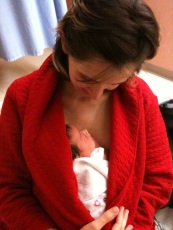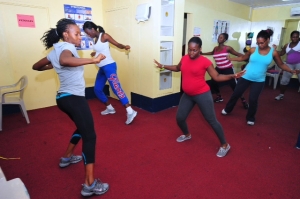“When a normal, healthy child is born, usually in the father’s compound, the women perform the nkwa to rejoice. Then…they sing and dance their way to the compounds of the mother’s kin to inform them of the joyous event through the dance-play, gathering additional dancers as it moves from compound to compound. In this nkwa, in which only married women who have given birth perform, the dancers highlight procreative body parts, birth exercises and child care gestures.” – page 164, Hanna JL, To Dance is Human: a theory of non-verbal communication, 1979. Rev. ed. 1987.
From its inception in 1979, Dancing Thru Pregnancy® has been inspired by this passage from Judith Lynne Hanna’s amazing text, in which she describes how the Ubakala of Nigeria “announce” the birth of a child. The dance serves a dual purpose – it tells of the birth, but it also teaches the uninitiated how pregnancy and birth occur. For the dancers it also serves as a catharsis.
As a professional dancer, I long ago recognized the transformative power of dance to make experiences accessible. Through Hanna’s writing we see how dance is itself one of the earliest and most profound ways in which common human experiences are taught and learned. Contemporary culture often removes this type of learning from our environment. Employing dance to help women approach birth has always struck me as an obvious first choice in preparing women for the physical, emotional, identity-forming and joyful process of birth.
Through Hanna’s writing we see how dance is itself one of the earliest and most profound ways in which common human experiences are taught and learned. Contemporary culture often removes this type of learning from our environment. Employing dance to help women approach birth has always struck me as an obvious first choice in preparing women for the physical, emotional, identity-forming and joyful process of birth.
In the intervening years, science and technology have reinforced our understanding of how this non-verbal learning happens. A most excellent discussion of mirror neurons appears in Acharya and Shukla’s article, Mirror Neurons: Enigma of the metaphysical modular brain, J Nat Sci Biol Med. 2012 Jul-Dec; 3(2): 118–124. http://www.ncbi.nlm.nih.gov/pmc/articles/PMC3510904/. Mirror neurons are key to how empathy and understanding of experience are produced when people view movement and gesture. The mere perception of an action sets off a low level firing of the neural pathway that executes the actions we are seeing. The authors provide a thorough grounding in the history of how we have come to recognize that mirror neurons exist and how they work.
There are more arenas in which dance also shines as a preparation. Appropriately choreographed, dance enables excellent physical fitness and includes all the elements of physical activity that research demonstrates are effective for optimal health in pregnancy and coping with the rigors of birth. From the perspective of exercise physiology, labor is an ultra-distance endurance event, followed by a strength test (birth), a long physical recovery period and 18 years or more of sleep deprivation. And, further, such a preparation aids the mother in achieving a physiologic birth as described in Buckley’s “Hormonal Physiology of Childbearing: Evidence and implications for women, babies, and maternity care.” This recent groundbreaking article describes how labor, birth and breastfeeding are promoted through hormonal actions, as well as why some technological advances in childbirth are working against these processes.
 Achieving cardiovascular endurance (aerobic fitness) is essential. There are so many benefits of aerobic fitness that a full recitation and hundreds of citations will not fit in a blog. Our teacher training aerobic component takes several days, even for experienced fitness pros. But, to summarize: cardiovascular fitness improves implantation, enhances nutrient and oxygen delivery, reduces the incidence or severity of some pregnancy disorders, reduces the risk of fetal distress, reduces stress on maternal cardiac reserve while pushing, reduces the risk of cesarean, hastens recovery, helps maintain a healthy weight, alleviates anxiety, builds body-image confidence (Cochrane) and enhances long term maternal and fetal health. The two forms of cardio or aerobic activity most often cited for effectiveness are running and aerobic dancing.
Achieving cardiovascular endurance (aerobic fitness) is essential. There are so many benefits of aerobic fitness that a full recitation and hundreds of citations will not fit in a blog. Our teacher training aerobic component takes several days, even for experienced fitness pros. But, to summarize: cardiovascular fitness improves implantation, enhances nutrient and oxygen delivery, reduces the incidence or severity of some pregnancy disorders, reduces the risk of fetal distress, reduces stress on maternal cardiac reserve while pushing, reduces the risk of cesarean, hastens recovery, helps maintain a healthy weight, alleviates anxiety, builds body-image confidence (Cochrane) and enhances long term maternal and fetal health. The two forms of cardio or aerobic activity most often cited for effectiveness are running and aerobic dancing.
Two other elements of dance that are useful for pregnant, birthing and parenting moms are strength and flexibility. There are  many movement actions derived from numerous dance forms that promote both power and elasticity in the muscles, connective tissue and skeletal structure. Some effective positions, movements and skills are shared with other disciplines: Traditional childbirth preparation, weight training, gymnastics, physical therapy, yoga, t’ai chi, pilates, boot camp, plyometrics, proprioceptor neuromuscular facilitation (PNF) techniques, Feldenkrais, Alexander, somatic therapies, posture training, etc.
many movement actions derived from numerous dance forms that promote both power and elasticity in the muscles, connective tissue and skeletal structure. Some effective positions, movements and skills are shared with other disciplines: Traditional childbirth preparation, weight training, gymnastics, physical therapy, yoga, t’ai chi, pilates, boot camp, plyometrics, proprioceptor neuromuscular facilitation (PNF) techniques, Feldenkrais, Alexander, somatic therapies, posture training, etc.
This letter I received recently from a (not pregnant) ballet student willing to share her experience is a clear reminder of how a well-designed dance class accomplishes enhancement of strength and flexibility, along with confidence about working with one’s body:
“Hi Ann,
I just wanted to let you know that I lifted weights at the gym last night… It had been at least 6 months since I had lifted weights at all, and so I figured I’d need to start at a relatively low weight and I’d be really sore the next day regardless. I was very surprised to find that I could easily lift the maximum weight I’ve ever lifted, which was the weight I used to lift at a time when I was lifting weights routinely several times a week. Every muscle group was strong. And today I am not sore at all. This is all to say that I am shocked at how much strength I’ve gained from ballet. I had no idea that just lifting my limbs against gravity could be so effective.
Thank you so much for having a class for beginner adults, and for your patience with all of us! I’m 42 years old at this point, and started ballet because I had noticed my core strength, flexibility and balance starting to really decline…I am so thrilled with the results from ballet even though I have such a long way to go!!! Plus it’s really fun. How I wish I would have discovered ballet in my 20s or 30s, since I didn’t learn it as a child!
Glenda G. Callender, MD FACS“
An additional arena in which dance shines is in building mind-body skills. Dancing relies on centering – aligning with gravity to produce the greatest efficiency for movement (balance) along with breathing as a component of movement. Centering also reduces the load on the nervous system and allows the brain to modulate into the parasympathetic nervous system state, also known as the relaxation response (autogenic training, hypnosis, meditation, progressive relaxation), the zone (athletes’ term), mindfulness (big in research presently), the trophotropic response (the scientific term) or the alpha state (the current fad term). Dancers sometimes refer to this as tuning in to the unconscious. The actual coordination of motions, such as pushing, is primarily unconscious. The conscious piece is keeping a clear image of the goal, while allowing the body to work. This is the skill that allows the birthing mother to follow her body’s urges, flowing with the labor rather than trying to control what is going on. It gives her access to the cathartic nature of birth as a dance.
 Align
Align
Breathe
Focus on the breath
Sense the movement within
Then, allow the body to dance…
A part of the dance experience I truly enjoy is a phenomenon known as muscle bonding. When a group does vigorous physical activity together – dancing together, a sports team, a drill team – a special kind of bond forms. Part of the euphoria is this muscle bonding experience. Those of us whose interest lies in understanding the mechanics of such things have a pretty good idea how this works – some of which is laid out in this blog and the reading links. But, that is not the wonder of it. The w onder of it is what the Ubakala women experience moving together to announce the birth of a child.
onder of it is what the Ubakala women experience moving together to announce the birth of a child.
When I am dancing with my pregnant ladies and we are in the grove with our modified hip hop routine, we are smiling at each other and feeling completely alive. We are breathing hard and working hard, but we are strong. My hope is always that when she senses that labor and birth are starting, a mom-to-be can get in that groove with the baby and support person. Birth as a dance.
No blog on pregnancy or birth is complete without a caveat. Every pregnancy and birth is unique. Sometimes things go wrong. But, mostly they go right! And, moms can optimize the experience. One of the greatest dangers to pregnancy and birth is sedentary behavior. Regular, vigorous, strength-inducing, flexibility gaining, mindfulness, relaxation muscle bonding fun is available. Check our U.S. and International Find-a-Class listing. If there is nothing near you, start something!
Filed under: Pregnancy Pathway | Tagged: aerobics, birth, cardiovascular fitness, exercise, fetus, health, healthy behavior, implantation, Judith Lynne Hanna, labor, mirror neurons, moms-to-be, physical fitness, placenta, pre/postnatal fitness instructor, pregnancy, pregnancy and birth, pregnancy exercise, pushing, weight, yoga | Leave a comment »
 DTP: Tell us about your work as a DTP teacher and a Doula.
DTP: Tell us about your work as a DTP teacher and a Doula.
 After we dance we relax and visualize and end with a discussion (sharing our thoughts and experiences to encourage each other).
After we dance we relax and visualize and end with a discussion (sharing our thoughts and experiences to encourage each other).











 onder of it is what the Ubakala women experience moving together to announce the birth of a child.
onder of it is what the Ubakala women experience moving together to announce the birth of a child.











